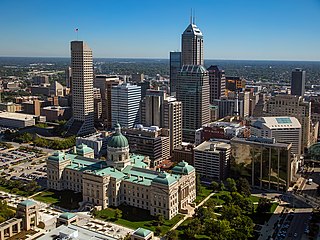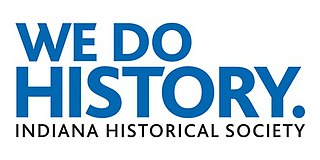Related Research Articles

Indianapolis, colloquially known as Indy, is the capital and most populous city of the U.S. state of Indiana and the seat of Marion County. Indianapolis is situated in the state's central till plain region along the west fork of the White River. The city's official slogan, "Crossroads of America", reflects its historic importance as a transportation hub and its relative proximity to other major North American markets.

The Indiana State Fair is an annual state fair that spans 15 days in August in Indianapolis, Indiana, U.S. The Indiana State Fair debuted in 1852 at Military Park in Indianapolis and is the sixth oldest state fair in the U.S. It is the largest event in the state, drawing between 730,000 and 980,000 visitors annually since 2010. In 2015, readers of USA Today ranked the Indiana State Fair among the ten best state fairs in the country.

White River State Park is an urban park in downtown Indianapolis, Indiana. Situated along the eastern and western banks of its namesake White River, the park covers 267 acres (108 ha). The park is home to numerous attractions, including the Eiteljorg Museum of American Indians and Western Art, the Indiana State Museum, the Indianapolis Zoo, the NCAA Hall of Champions, Victory Field, Everwise Amphitheater, and White River Gardens.

Fort Harrison, sometimes called Fort Ben, is an Indiana state park located in Lawrence, Indiana, United States, and occupies part of the former site of Fort Benjamin Harrison. The park features a former Citizen's Military Training Camp, Civilian Conservation Corps camp, and World War II prisoner of war camp. There are also picnicking and walking/jogging trails including a connection to the Fall Creek Greenway. The park receives nearly 900,000 visitors annually.

The 1987 Pan American Games, officially known as the X Pan American Games, was a major international multi-sport event held in Indianapolis, Indiana, United States, on August 7–23, 1987. Over 4,300 athletes from 38 countries in the Americas competed in 297 events in 30 sports, earning 1,015 medals. Events were held at 23 venues in and around Indianapolis. The official mascot for the games was Amigo, a green parrot.

Hinkle Fieldhouse is a basketball arena on the campus of Butler University in Indianapolis, Indiana. Completed in early 1928, it was the largest basketball arena in the United States until 1950. The facility was renamed Hinkle Fieldhouse in 1966 in honor of Butler's longtime coach and athletic director, Paul D. "Tony" Hinkle. It is the sixth-oldest college basketball arena still in use. Added to the National Register of Historic Places in 1983 and designated a U.S. National Historic Landmark in 1987, Hinkle Fieldhouse is sometimes referred to as "Indiana's Basketball Cathedral."

The history of Indianapolis spans three centuries. Founded in 1820, the area where the city now stands was originally home to the Lenape. In 1821, a small settlement on the west fork of the White River at the mouth of Fall Creek became the county seat of Marion County, and the state capital of Indiana, effective January 1, 1825. Initially the availability of federal lands for purchase in central Indiana made it attractive to the new settlement; the first European Americans to permanently settle in the area arrived around 1819 or early 1820. In its early years, most of the new arrivals to Indianapolis were Europeans and Americans with European ancestry, but later the city attracted other ethnic groups. The city's growth was encouraged by its geographic location, 2 miles (3.2 km) northwest of the state's geographic center. In addition to its designation as a seat of government, Indianapolis's flat, fertile soil, and central location within Indiana and the Midwest, helped it become an early agricultural center. Its proximity to the White River, which provided power for the town's early mills in the 1820s and 1830s, and the arrival of the railroads, beginning in 1847, established Indianapolis as a manufacturing hub and a transportation center for freight and passenger service. An expanding network of roads, beginning with the early National Road and the Michigan Road, among other routes, connected Indianapolis to other major cities.

Tom Carnegie, born Carl Lee Kenagy, was an American radio and television broadcaster, public-address announcer, sports columnist, documentary filmmaker, and educator from Norwalk, Connecticut. Carnegie's radio and television broadcasting career, which spanned from 1942 to 1985, included work at KITE radio in Kansas City, Missouri; WOWO (AM) radio in Fort Wayne, Indiana; and WIRE (AM) radio in Indianapolis, Indiana. Carnegie was also sports director for WRTV television in Indianapolis for thirty-two years, and broadcast the Indiana high school boys' basketball tournament for twenty-four years.

The Indiana Historical Society (IHS) is one of the United States' oldest and largest historical societies. It describes itself as "Indiana's Storyteller".

IU Michael A. Carroll Track & Soccer Stadium is a 12,100-seat soccer and track and field stadium located in Indianapolis, Indiana, United States. It is the home of the Indiana University Indianapolis Jaguars track and field and soccer teams. It is also the home of Indy Eleven.

Indiana, a state in the Midwest, played an important role in supporting the Union during the American Civil War. Despite anti-war activity within the state, and southern Indiana's ancestral ties to the South, Indiana was a strong supporter of the Union. Indiana contributed approximately 210,000 Union soldiers, sailors, and marines. Indiana's soldiers served in 308 military engagements during the war; the majority of them in the western theater, between the Mississippi River and the Appalachian Mountains. Indiana's war-related deaths reached 25,028. Its state government provided funds to purchase equipment, food, and supplies for troops in the field. Indiana, an agriculturally rich state containing the fifth-highest population in the Union, was critical to the North's success due to its geographical location, large population, and agricultural production. Indiana residents, also known as Hoosiers, supplied the Union with manpower for the war effort, a railroad network and access to the Ohio River and the Great Lakes, and agricultural products such as grain and livestock. The state experienced two minor raids by Confederate forces, and one major raid in 1863, which caused a brief panic in southern portions of the state and its capital city, Indianapolis.
During the American Civil War, Indianapolis, the state capital of Indiana, was a major base of supplies for the Union. Governor Oliver P. Morton, a major supporter of President Abraham Lincoln, quickly made Indianapolis a gathering place to organize and train troops for the Union army. The city became a major railroad hub for troop transport to Confederate lands, and therefore had military importance. Twenty-four military camps were established in the vicinity of Indianapolis. Camp Morton, the initial mustering ground to organize and train the state's Union volunteers in 1861, was designated as a major prisoner-of-war camp for captured Confederate soldiers in 1862. In addition to military camps, a state-owned arsenal was established in the city in 1861, and a federal arsenal in 1862. A Soldiers' Home and a Ladies' Home were established in Indianapolis to house and feed Union soldiers and their families as they passed through the city. Indianapolis residents also supported the Union cause by providing soldiers with food, clothing, equipment, and supplies, despite rising prices and wartime hardships, such as food and clothing shortages. Local doctors aided the sick, some area women provided nursing care, and Indianapolis City Hospital tended to wounded soldiers. Indianapolis sent an estimated 4,000 men into military service; an estimated 700 died during the war. Indianapolis's Crown Hill National Cemetery was established as one of two national military cemeteries established in Indiana in 1866.

Military Park is the oldest urban park in Indianapolis, Indiana, covering 14 acres (6 ha). It is located in western downtown Indianapolis. It was added to the National Register of Historic Places on October 28, 1969.
Sharon Lynn Wichman, also known by her married name Sharon Jones, is an American former competition swimmer and 1968 Olympic champion in the breaststroke.

Indiana is a state in the Midwestern region of the United States. It borders Lake Michigan to the northwest, Michigan to the north and northeast, Ohio to the east, the Ohio River and Kentucky to the south and southeast, and the Wabash River and Illinois to the west. Nicknamed "the Hoosier State", Indiana is the 38th-largest by area and the 17th-most populous of the 50 states. Its capital and largest city is Indianapolis. Indiana was admitted to the Union as the 19th state on December 11, 1816.

The Indianapolis Park and Boulevard System is a group of parks, parkways, and boulevards in Indianapolis, Indiana, that was designed by landscape architect George Edward Kessler in the early part of the twentieth century. Also known as the Kessler System, the district includes 3,474 acres (1,406 ha) and has shaped the city through the present day. This historic district was added to the National Register of Historic Places in 2003.

The 2018–19 Indiana Hoosiers men's basketball team represented Indiana University in the 2018–19 NCAA Division I men's basketball season. Their head coach was Archie Miller, his second year as Indiana head coach. The team played its home games at Simon Skjodt Assembly Hall in Bloomington, Indiana, as a member of the Big Ten Conference. The season officially kicked off with its annual event, Hoosier Hysteria, on September 29, 2018.
Robert Vincent Welch was an American businessman, politician, and civic leader from Indianapolis, Indiana.
The National Institute for Sports and Fitness (NIFS) building was constructed in 1987. The building works with the IU School of Physical Education and Tourism Management. The building is located on the IUPUI campus and in White River State Park. The fitness center was constructed alongside the Michael A. Carroll Track & Soccer Stadium and the Natatorium to position IUPUI as a major physical education and sports leader for the city. The Indianapolis Tennis Center and the other facilities would host a series of events, competitions, and programs in conjunction with the city of Indianapolis and IUPUI.
References
- ↑ Bodenhamer, David. The Encyclopedia of Indianapolis (Indiana University Press, 1994) p.1426
- 1 2 3 4 Bodenhamer p.1426
- 1 2 Bodenhamer p.1427
- ↑ McMahon, Alicia. Sports, Inc.Indiana Business Magazine April 1, 1990
- ↑ Bell, Matt. WHITE RIVER ATHLETES LOVE FITNESS, COMPETITION THERE WILL BE 1,031 PARTICIPANTS FROM THE FORT WAYNE REGIONAL. (Fort Wayne, Indiana) July 16, 1993, Page 4S
- ↑ Sebring, Blake. NEW NAME, SAME GAME FOR STATE TOURNAMENT THE FORMER WHITE RIVER PARK GAMES GOT A NEW HANDLE.The News-Sentinel (Fort Wayne, Indiana) June 22, 1995, Page 1S
- ↑ McMahon